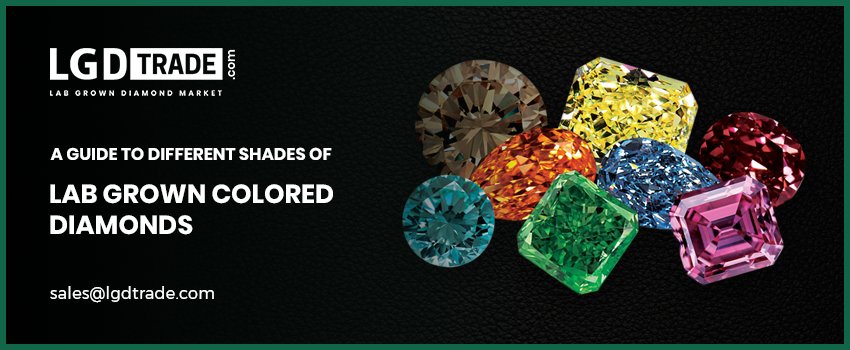
The term “diamond” is often used to refer to any gemstone with the same crystalline structure and appearance as the diamond. But in reality, most diamonds are mined right out of the ground. Lab-grown colored diamonds or synthetic diamonds are created inside a lab by placing carbon under high heat and pressure until it becomes what’s called “diamond nanorods.” Gemologists use different terms for these materials depending on their size, clarity, color quality, and other factors. Here is an overview of the most common types of lab-grown colored diamond gems:
- White diamonds:
White diamonds are the most common type of lab-grown colored diamond and make up more than 75% of all gem-quality diamonds. They get their name from their stark contrast against a black background.
- Yellow diamonds:
Yellow diamonds are the second most common type of diamond. They get their yellow color from nitrogen impurities in the carbon crystal.
- Brown diamonds:
Brown diamonds are less common than white or yellow diamonds, but they’re still one of the most popular types of lab-grown colored diamonds. They get their brown color from natural impurities in the diamond crystal.
- Pink diamonds:
Pink diamonds are some of the rarest and most sought-after types of lab-grown diamonds. They get their pink color from boron impurities in the diamond crystal.
- Blue diamonds:
Blue diamonds are even rarer than pink diamonds and are some of the most valuable gemstones in the world. They get their blue color from trace amounts of hydrogen impurities in the diamond crystal.
- Green diamonds:
Green diamonds are another rare type of lab-grown diamond. They get their green color from small amounts of radiation exposure during the growth process.
- Colorless diamonds:
Colorless diamonds, also known as “white synthetic diamonds,” are a type of lab-grown diamond that doesn’t have any detectable color. They’re often used in jewelry to create “diamond accents” or “diamond enhancements.”
Lab-grown colored diamonds are a popular choice for jewelry because they’re more affordable than natural diamonds, and they have the same look and feel as mined diamonds. They’re also a sustainable option because they’re created using renewable resources. If you’re looking for a beautiful diamond gem that’s eco-friendly and affordable, then lab-grown diamonds are a perfect choice!
Let’s talk about different grades of lab-grown colored diamonds:
There are many different grades to choose from when it comes to lab-grown diamonds. Here is a breakdown of the most common grades:
1) Commercial-grade: Commercial-grade diamonds are the lowest quality of lab-grown diamonds. They have low clarity, color, and cut ratings, and they’re often used in industrial applications.
2) Industrial grade: Industrial grade diamonds are a step up from commercial-grade diamonds. They have higher clarity, color, and cut ratings, and they’re often used in jewelry or other decorative applications.
3) Standard grade: Standard grade diamonds are the most common type of lab-grown diamond. They have good clarity, color, and cut ratings, and they’re perfect for everyday wear.
4) Premium grade: Premium grade diamonds are the highest quality of lab-grown diamonds. They have excellent clarity, color, and cut ratings, and they’re perfect for special occasions.
When shopping for lab-grown diamonds, it’s essential to understand the different grades and what they mean. It’s also important to remember that grades can vary from one diamond retailer to the next, so it’s always best to shop around and compare prices.
Let’s talk about some other color or shades related questions:
- Which is the best color?
There is no one “best” color for lab-grown diamonds. Each color has its own unique set of characteristics and appeal. So it depends on what you’re looking for in a diamond gem.
If you’re looking for a classic white diamond, white lab-grown diamonds are the best choice. If you’re looking for a lively, yellow diamond, then yellow lab-grown diamonds are the way to go. And if you’re looking for something out of the ordinary, brown or pink lab-grown diamonds are a great option.
- Which diamond is worthy of its price?
When it comes to diamonds, price is often determined by various factors, including size, clarity, and color. Natural diamonds are usually more expensive than lab-grown diamonds, but a few exceptions. Blue diamonds, for example, are some of the rarest and most valuable gems in the world and can be more expensive than their white counterparts.
But when it comes down to it, what makes a diamond worth its price? In the end, it’s really up to the individual. Some people might prefer the natural look and feel of a mined diamond, while others might prefer the affordability and sustainability of lab-grown diamonds. It comes down to personal preference.
Lab-grown diamonds are a beautiful, sustainable choice for anyone looking for a quality diamond gem. With so many different colors to choose from, there’s sure to be a lab-grown diamond that’s perfect for you!
- Which color looks identical to a natural diamond?
All colors of lab-grown diamonds look nearly identical to natural, mined diamonds. They’re created using the same technology and process as mined diamonds. So if you’re looking for a diamond gem that’s indistinguishable from a natural diamond, then lab-grown diamonds are a perfect choice!
In conclusion,
lab-grown diamonds are a great eco-friendly alternative to mined diamonds. They’re created using the same process and technology as natural gems, so it’s nearly impossible for anyone but experts to tell them apart from natural diamonds. Different grades of lab-grown diamond exist, which depend on clarity, color, and cut quality. The most common type of the lab-grown gem is called standard grade. They have good clarity, color, or cut ratings that make them perfect for everyday wear in jewelry applications with decorative purposes such as rings or necklaces. Premium grade stones are higher quality than standard with excellent clarity and high scores on both color and cut rating scales making these types ideal for special occasions like weddings when you want your ring or necklace to sparkle just suitable!